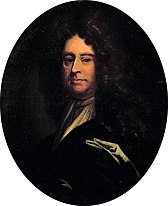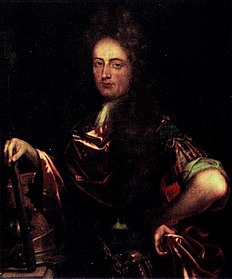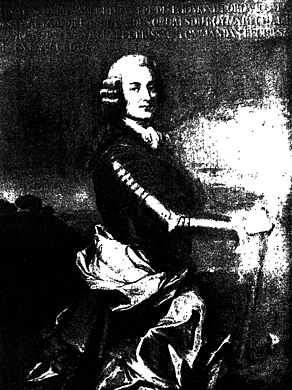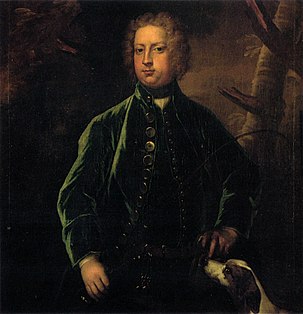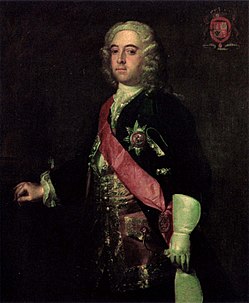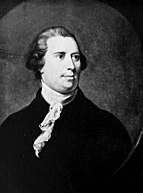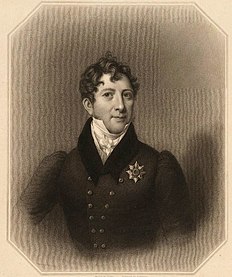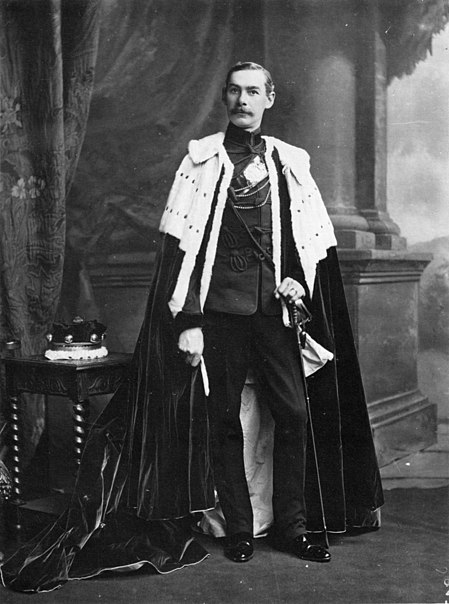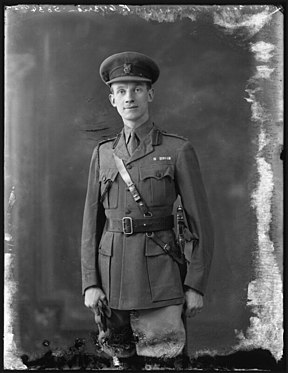Dalcassians
| Dalcassians | |||
|---|---|---|---|
| Dál gCais | |||
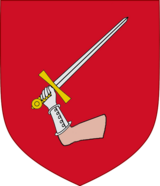 The early Dál gCais carried on their banners theClaíomh SolaisofNuada.[1]One of theFour Treasures of the Tuatha Dé Danann. | |||
| Profile | |||
| Country | Ireland | ||
| Region | Thomond | ||
| Ancestry | Déisi Tuisceart | ||
| Ethnicity | GaelicIrish | ||
| Founder | Cas | ||
| Chief | |||
| Conor John Anthony, 19th Baron Inchiquin | |||
| Historic seat | Dromoland Castle | ||
| |||
| |||
| |||
TheDalcassians(Irish:Dál gCais[ˌd̪ˠaːlˠˈɡaʃ]) are aGaelicIrish clan,generally accepted by contemporary scholarship as being a branch of theDéisi Muman,that became very powerful in Ireland during the 10th century. Their genealogies claimed descent fromTál Cas.Their known ancestors are the subject ofThe Expulsion of the Déisitale and one branch of their blood-line went on to rule the petty kingdom ofDyfedin Wales during the 4th century; probably in alliance with theRoman EmperorMagnus Maximus.
Brian Bórumais perhaps the best-known king from the dynasty and was responsible to a significant degree for carving out their fortunes. The family had built a power base on the banks of theRiver Shannonand Brian's brotherMahonbecame their firstKing of Munster,taking the throne from the rivalEóganachta.This influence was greatly extended under Brian who becameHigh King of Ireland,following a series of wars againstHiberno-Norsekingdoms and theChiefsof other Irish clans, before dying famously at theBattle of Clontarfin 1014. Following this the Dál gCais provided three more High Kings of Ireland;Donnchad mac Briain,Toirdelbach Ua BriainandMuirchertach Ua Briain.
From the 12th–16th centuries, the Dál gCais contented themselves with being reduced to theKingdom of Thomond.They attempted to claim theKingdom of Desmondfor a time, but ultimately theMacCarthysheld it. The Kennedys also held theKingdom of Ormondfor a time. Some of the better known septs includedO'Brien,Moloney,MacNamara,O'Grady,O'Gorman,Galvin,Kennedy,MacMahon,McInerney,andClancy.During the 13th centuryRichard Strongbow's relatives the Normande Claresattempted to take Thomond, but the Dál gCais held firm.
It wasn't until the 16th century, unable to be defeated militarily, that they agreed to surrender and regrant their kingdom toHenry VIII Tudor,joining the nobility of theKingdom of Ireland.Their realm was renamedCounty Clare,though they remained influential. In later times, remarkable figures include writerStandish James O'Grady,who is called "Father of theCeltic Revival"andWilliam Smith O'Brienwho played a leading part in theYoung Irelander Rebellionof 1848. In diaspora, prominent figures have included MarshalPatrice de Mac-Mahon,President of France,[2][3]as well asJohn F. Kennedy[4]andRonald Reagan,[5]who were bothPresidents of the United States.
History
[edit]Origins, Déisi Muman vs. Deirgtine
[edit]In their own genealogies, the Dál gCais traced their line back to their eponymous ancestor and progenitor Cormac Cas, who is said to have lived in the 2nd to 3rd century. They make him a second son ofAilill Aulomfrom theDeirgtine,aKing of MunsterandLeath Mogamore generally, associated in a story with the goddessÁineof theTuatha Dé Danannduring theCycles of the KingsofIrish mythology.Cormac Cas himself was purported to be the younger brother ofEógan,founder of theEóganachta,who would go on to rule Munster for many centuries. While this was taken on face value for a long time, later Irish scholars came to question its validity, regarding it as a politically motivated fabrication. The Dál gCais were becoming powerful in the 10th century, withMahonand his brotherBrian Bórumataking the throne in Munster from the Eóganachta; claiming ancient kinship with their rivals would have boosted their legitimacy.

It is claimed by current scholarship that the Dál gCais were instead a branch of theDéisi Muman.[6][7]The Déisi Muman held avassal kingshipin Munster under the Eóganachta, significant in scope, consisting of what is todayWaterfordand its environs. As time went on branches also emerged around theRiver Shannon,as part of the Déisi Muman moved north-westerly between the 5th and early 8th century; they were called the Déisi Deiscirt and the Déisi Tuisceart. It is from a later, more northerly branch, which the Dál gCais are said to ultimately find their true ancestors.[6]The first recorded mention of their adoption of the new name Dál gCais specifically is in theAnnals of Inisfallenfor the year 934, which records the death of their king Rebachán mac Mothlai.
The Déisi Muman themselves are the subject ofThe Expulsion of the Déisiepic in the Cycles of the Kings, which is set during the time thatCormac UlfadawasHigh King of Ireland.The story describes the expulsion of theDal Fiachrach Suighe;kinsmen of theConnachtaand descendants ofFedlimid Rechtmar;fromTara,coming to settle in Munster after many battles. Upon becoming the Déisi Muman, one branch then sailed across toBritainin the 4th century, coming to ruleDyfed.Their presence in Britain may have been initially supported byMagnus Maximus,Roman Emperor,as part of a policy of backingGaelicvassals to be seafaring defenders of the shores of Britain facing theIrish Seafrom pirates.[8]Eoin MacNeillhas pointed out that they were not the only Irish colony in the area, with theUí Liatháinalso powerful. Historian C. Thomas Cairney stated that the Dal gCais along with theDéisiwere tribes of theErainnwho were the second wave ofCeltsto settle in Ireland from about 500 to 100BC.[9]
Ascent to the High Kingship of Ireland
[edit]The adoption of the name Dál gCais and the ascent of the group to greater power began to take place during the 10th century with internal political transition.[7]With the death of Rebachán mac Mothlai, the leadership of the Déisi Tuisceart shifted from theUí Aengusakindred to their junior relatives theUí Thairdelbaig.[7]It was during the time ofCennétig,[7]who styled himselfKing of Thomond,that the Dál gCais began to challenge the Eóganachta; though Kennedy was defeated at the Battle of Gort Rotacháin byCellach Caisil,King of Munsterin 944. The actual reason for this sudden surge has been much debated and one frequently discussed thesis is that it was a political scheme of theUí Néill,intending to use the Dál gCais as proxies to further weaken the power of the Eóganachta.[10]

Kennedy's children built on their father's achievements. His daughter Órlaith became Queen consort of Ireland, after she marriedDonagh Donn,a High King of Ireland from thesouthern branchof the Uí Néill.Mahonbecame the first Dál gCais to gain the kingship of Munster, after he seized theRock of CashelfromMolloyof the Eóganachta. Leading up to this he had defeated the Norse underIvar of Limerickat theBattle of Sulcoitin 968. After Mahon was captured byDonovanin 976 and murdered by Molloy, the Eóganachta returned to the throne at Cashel for two years, but Mahon's younger brotherBrian Bóruma,a seasoned military man from the early campaigns, would desire vengeance.
A campaign in 977-78 led to the defeat and death of Ivar, with an engagement atScattery Islandbeing the most significant. Brian retained the formerly Norse Limerick for its trading power and naval strength. The Dál gCais took back Munster atBelach Lechtathe same year, killing Molloy in the process. Ambition saw Brian look next to the territories ofMalachy II,High King of Ireland. A closely contested war of 15 years ensued, with the naval ability of the Dál gCais paying off as a truce was called by Malachy in 997, recognising Brian's overlordship ofLeath Moga.They became allies against theNorse Dublinand theLaiginwho underMáel Mórda,King of Leinsterhad risen against Brian's claims. The latter were subdued atGlenmamain 999, before rebelling again in 1014 atClontarfwhere Norse power in Ireland was finally broken, though Brian died in the process. In the interim, Malachy had passed the High Kingship to Brian in 1002 and he built strong Christian links toArmagh.Historian C. Thomas Cairney stated that the Dal gCais were the axe-wielding foot-soldiers who formed the core of the army that defeated the Vikings in 1014.[9]
After the death of Brian, his two established surviving sons;DonaghandTeague;struggled in an internal Dál gCais rivalry for dominion. While Donagh was High King, many other Irish kings allied against him, including Leinster, Connacht, and Ulster. Deposed in 1063, he fled to Rome, with some sources claiming he grantedPope Urban IIthe Irish crown, this is controversial, however.[note 1]Teague's sonTurloughtook up the reins in a lasting alliance with the powerfulDermot Kinsella, King of Leinster.Not a military leader, Turlough was instead a capable politician, theCogad Gáedel re Gallaibglorifying Brian's feats would be authored during his lifetime. Turlough's sonMurtaghwould be the last High King from the Dál gCais of the medieval period, reigning between 1101–19. Murtagh attempted to make the Irish kingship more along the lines of European monarchies and was involved in foreign affairs (allying withArnulf de Montgomeryin theWelsh MarchesagainstHenry I,King of England), trying to extend Irish influence beyond internal rivalries.
Dynastic divisions
[edit]Septs and kindreds
[edit]The septs of the Dál gCais developed over time, with new ones breaking off to form separate surnames at different times, but all claiming to share the same paternal line (with a few biological exceptions along the way due to adoption or extra-marital issue). Their eponymous founder Cas had several sons; two of them gave their names to theUí BloidandUí Caisinkindreds, and another founded theUi Fearmaic.As the proto-Dál gCais moved up into what is todayEast Clare,these became associated with rooted tribal areas, but were themselves internally divided into any other septs.[11]
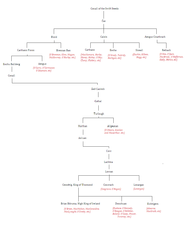


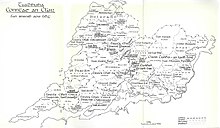
The senior line descended from Cas' first son Bloid and they provided theKings of Thomond.Initially, the leaders of the tribe were a sept known as theUí Aengusafrom which descendsO'Curry,O'CormacanandO'Seasnain.However, during the 10th century, this passed to the juniorUí Thairdelbaig.It is this kindred which would furnish theHigh Kings of Irelandand theKings of Thomondincluding Brian Bóruma. From theUí ThairdelbaigcameO'Brien,O'Kennedy(who wereKings of Ormond),MacConsidine,MacMahon,O'Reagan, MacLysaght,O'Kelleher,Boland, Cramer, Kearney,O'Casey,Power,Twomey,Eustace,Ahearne,MacGrath,Quick,O'Meara,Scanlan, MacArthur,Cosgrave,O'Hogan,Lonergan and others.[12][13]O'Noonan and Coombe are other notableUí Bloiddescendants.[12]A younger brother of Carthann Fionn (who both theUí ThairdelbaigandUí Aengusaderive) named Brennan Ban stands at the head of the genealogies for theO'Brennan,Glinn,MuldowneyandO'Hurleysepts.[12]
Although a junior line, theUí Caisincontinued to have a prominent role and the leader of their kindred in Thomond were theMacNamara,who as Lords of Clancullen, were the second most powerful family after the O'Brien.[14]Other families descended from the branch of Carthann (son of Caisin) includeHarley,Flood,Torrens, Stoney,Hickey,O'Hay,Clancy, Neylon andFlattery.[15]Carthann had brothers named Eocha and Sineall from whom descend theO'Grady,Tubridy,Hartigan, Durkin, Killeen andHogg.[16][17][18]In addition to this, there are theUi Fearmaic[19]who claim to descend from Aengus Cinathrach, a brother of Caisin and Bloid. This kindred included theO'Deaas leaders, as well as theO'Quin,O'Griffin / O'Griffey(chieftains of Cineal Cuallachta),O'Heffernan,Kieltyand Perkin.[20] [21][22]
Titles and social roles
[edit]Within the traditionalGaelic cultureof Ireland, society rested on the pillars of the tribal nobility, bardic poet historians and priests.[23]Different families had different roles to play and in many cases, this was a hereditary role. However, the nature of this system, known astanistrywasaristocratic( "rule by the best" ) in the truest sense, in that if the tribe thought a younger male member of the family was more suitable to succeed to a role than an older sibling, then they could. TheNormanand wider European concept of strictprimogeniturewas not completely adopted until after some of the families joined the peerage of Ireland.
The most powerful Dalcassian family of thehereditary Gaelic nobilitywere the O'Brien (Kings of Thomond), followed by MacNamara (Lords of Clann Cuilean), O'Kennedy (Kings of Ormond), MacMahon (Lords ofCorca Baiscinn),[2]O'Grady (Lords of Cinél Dongaile) and O'Dea (Lords of Ui Fearmaic). Some of these families later joined thepeerage of Irelandafter the surrender and regrant to theTudorsduring the 16th century. The O'Brien was initiallyEarls of Thomond,but later becameBarons Inchiquinwhich they hold to this day. The O'Grady wasViscounts Guillamore,while the O'Quins becameEarls of Dunraven.[20]A branch of the MacMahon family became Marquis de MacMahon d'Eguilly[3]in theKingdom of France,later raised toDukes of Magentaunder EmperorNapoleon III.
The Clancy sept was the hereditaryBrehonsof Thomond and held a very powerful position when it came to the law in the kingdom.[24]Even after the end of the Gaelic order, they continued to play a role, providing aHigh Sheriff of Clarein the form ofBoetius Clancy.[24]Famously participating in theContention of the Bardsin support of the honour of the tribe, the MacBrody sept were the principal poets and historians of the Dál gCais for centuries.[25][26]TheO'HickeyandNeylon[27]sept would serve as hereditary physicians to the Dalcassians of Thomond. After the NormanButler dynastytook Ormond, the Dalcassian sept ofO'Mearabecame their hereditary physicians, this line includedBarry Edward O'Meara,who was with EmperorNapoleon Iin exile atSt. Helena.
Chieftainship
[edit]What became known as the Dál gCais stemmed from the Deisi Becc (Small Deisi) who controlled a narrow strip of land stretching from the Ballyhoura mountains to the Shannon and were divided into the Deisi Deiscirt (Southern Deisi, centred around Bruree) and Deisi Tuaiscirt (Northern Deisi, centred around Cahernarry) who shared a common ancestry.[28]Their conquest of modern Clare probably occurred after the Battle of Carn Feradaig in 629AD where, under their king Díoma mac Rónáin, they defeated the King of ConnachtGuaire Aidne mac Colmáinwho was invading Munster. After this, their Kings first appear in contemporary records. Andelait, son of Díoma is one of eightMunsterkings listed as guarantors of theCáin Adomnáinin 697. In 713 the Deisi Tuaiscirt killed theKing of CashelCormac mac Ailelloin battle at Carn Feradaig after he had invaded their territories. In 744 the annals note: "Destruction ofCorco Mruadby the Déis"which indicates their power in Thomond was growing. In 765 the death of their king Torpaid is noted in the annals. From this point forward the annals are silent on the Deisi Tuaiscirt until 934.[29]
In 934 the annals report the death of Reabacán mac Mothla who is described as King of the Dál gCais (the earliest extant usage of this dynastic name) and Abbot of Tuaim Gréine and in the same year his son was killed by one of the sons of Lorcáin mac Lachtna (who is said to succeed Rebeacán as king), the annals report "Duibhghiolla, son of Robacáin, Lord of Ua Corbmaic, was murdered by Congalach son of Lorcáin in treachery".This action must have paved the way for Lorcán and his sons to seize power.[30]Lorcán was descended from theUí Toirdhealbhachinstead of theUí Oengussowho had hitherto comprised the Deisi Tuaiscirt kings.Cinnéidigh,another son of Lorcáin, who became king after his father, expanded the power of the Dál gCais greatly and was noted asKing of Thomondin the annals by his death. His sonMathgamainbuilt on his achievements, capturingCasheland becomingKing of Munster.The best-known member of this dynasty,Brian Boru,took over after his brother Mathgamain's death, reclaimed the Munster kingship and eventually succeeded in establishing himself asHigh King of Irelandbefore his famous death in theBattle of Clontarf.
The Dál gCais under Brian's descendants, theUa Briainwould provide a further threeHigh Kings of Irelandand exercised supremacy inMunsteruntilTairrdelbach Ua Conchobair,taking advantage of war between brothersDiarmaitand former High-KingMuircheartach,invadedMunsterand split it in two in the Treaty of Glanmire (1118) grantingThomondto the sons ofDiarmait Ua BriainandDesmondto the leading sept of the dispossessedEoganacht,theMac Cárthaighdynasty. After the death ofDomnall Mór Ua Briain,a claimant to the Kingship of Munster, they further retreated beyond theShannoninto the area of modernCounty Clarein the wake of theNorman Invasion.In 1276King Edward IIgranted all ofThomondtoThomas de Clare,taking advantage of the feuding between Clann Taidhg and Clann Briain (whom de Clare supported). The de Clares failed in conquering Thomond and were decisively defeated in theBattle of Dysert O'Deain 1318, thus theKingdom of Thomondremained outside of foreign control for a further 200 years.[31]
In 1543Murchadh Carrach Ó Briain,agreed tosurrenderhisGaelic RoyaltytoKing Henry VIIIand accepted the titlesEarl of ThomondandBaron Inchiquin.At his death in 1551, the Earldom passed to his nephewDonoughby special remainder and the titleBaron Inchiquinpassed to his male heirs through his sonDermot.The Earldom went extinct at the death ofHenry O'Brien, 8th Earl of Thomond,the next heir would have been a descendant ofDaniel O'Brien, 3rd Viscount Clarewho wasattaindedin 1691, so the title becameforfeit.However,Charles O'Brien, 6th Viscount Clare,aJacobiteexile used the title Earl of Thomond, as did his son, who died childless in 1774. At the death ofJames O'Brien, 3rd Marquess of Thomond,the titleBaron Inchiquinpassed to a distant cousin and descendant ofMurrough,Sir Lucius O'Brien, 5th Baronetand was passed down to his descendants.
This early list of Dál gCais Kings is supplied inAn Leabhar Muimhneach.[32]
Key:
 =King of Northern Deisi
=King of Northern Deisi =King of Thomond
=King of Thomond =Baron Inchiquin
=Baron Inchiquin =Viscount Clare
=Viscount Clare =Earl of Thomond,Earl of Inchiquin
=Earl of Thomond,Earl of Inchiquin =Marquess of Thomond
=Marquess of Thomond
A higher Kingship title which is mutually inclusive with a lower one within the dynasty are not given overlapping dates for the simplicity of the chart.
| List of Kings (and later heads) of the Dál gCais | |||||||||||||||||||||||||||||||||||||||||||||||||||||||||||||||||||||||||||||||||||||||||||||||||||||||||||||||||||||||||||||||||||||||||||||||||||||||||||||||||||||||||||||||||||||||||||||||||||||||||||||||||||||||||||||||||||||||||||||||||||||||||||||||||||||||||||||||||||||||||||||||||||||||||||||||||||||||||||||||||||||||||||||||||||||||||||||||||||||||||||||||||||||||||||||||||||||||||||||||||||||||||||||||||||||||||||||||||||||||||||||||||||||||||||||||||||||||||||||||||||||||||||||||||||||||||||||||||||||||||||||||||||||||||||||||||||||||||||||||||||||||||||||||||||||||||||||||||||||||||||||||||||||||||||||||||||||||||||||||||||||||||||||||||||||||||||||||||||||||||||||||||||||||||||||||||||||||||||||||||||||||||||||||||||||||||||||||||||||||||||||||||||||||||||||||||||||||||||||||||||||||||||||||||||||||||||||||||||||||||||||||||||||||||||||||||||||||||||||||||||||||||||||||||||||||||||||||||||||||||||||||||||||||||||||||||||||||||||||||||||||||||||||||||||||||||||||||||||||||
|---|---|---|---|---|---|---|---|---|---|---|---|---|---|---|---|---|---|---|---|---|---|---|---|---|---|---|---|---|---|---|---|---|---|---|---|---|---|---|---|---|---|---|---|---|---|---|---|---|---|---|---|---|---|---|---|---|---|---|---|---|---|---|---|---|---|---|---|---|---|---|---|---|---|---|---|---|---|---|---|---|---|---|---|---|---|---|---|---|---|---|---|---|---|---|---|---|---|---|---|---|---|---|---|---|---|---|---|---|---|---|---|---|---|---|---|---|---|---|---|---|---|---|---|---|---|---|---|---|---|---|---|---|---|---|---|---|---|---|---|---|---|---|---|---|---|---|---|---|---|---|---|---|---|---|---|---|---|---|---|---|---|---|---|---|---|---|---|---|---|---|---|---|---|---|---|---|---|---|---|---|---|---|---|---|---|---|---|---|---|---|---|---|---|---|---|---|---|---|---|---|---|---|---|---|---|---|---|---|---|---|---|---|---|---|---|---|---|---|---|---|---|---|---|---|---|---|---|---|---|---|---|---|---|---|---|---|---|---|---|---|---|---|---|---|---|---|---|---|---|---|---|---|---|---|---|---|---|---|---|---|---|---|---|---|---|---|---|---|---|---|---|---|---|---|---|---|---|---|---|---|---|---|---|---|---|---|---|---|---|---|---|---|---|---|---|---|---|---|---|---|---|---|---|---|---|---|---|---|---|---|---|---|---|---|---|---|---|---|---|---|---|---|---|---|---|---|---|---|---|---|---|---|---|---|---|---|---|---|---|---|---|---|---|---|---|---|---|---|---|---|---|---|---|---|---|---|---|---|---|---|---|---|---|---|---|---|---|---|---|---|---|---|---|---|---|---|---|---|---|---|---|---|---|---|---|---|---|---|---|---|---|---|---|---|---|---|---|---|---|---|---|---|---|---|---|---|---|---|---|---|---|---|---|---|---|---|---|---|---|---|---|---|---|---|---|---|---|---|---|---|---|---|---|---|---|---|---|---|---|---|---|---|---|---|---|---|---|---|---|---|---|---|---|---|---|---|---|---|---|---|---|---|---|---|---|---|---|---|---|---|---|---|---|---|---|---|---|---|---|---|---|---|---|---|---|---|---|---|---|---|---|---|---|---|---|---|---|---|---|---|---|---|---|---|---|---|---|---|---|---|---|---|---|---|---|---|---|---|---|---|---|---|---|---|---|---|---|---|---|---|---|---|---|---|---|---|---|---|---|---|---|---|---|---|---|---|---|---|---|---|---|---|---|---|---|---|---|---|---|---|---|---|---|---|---|---|---|---|---|---|---|---|---|---|---|---|---|---|---|---|---|---|---|---|---|---|---|---|---|---|---|---|---|---|---|---|---|---|---|---|---|---|---|---|---|---|---|---|---|---|---|---|---|---|---|---|---|---|---|---|---|---|---|---|---|---|---|---|---|---|---|---|---|---|---|---|---|---|---|---|---|---|---|---|---|---|---|---|---|---|---|---|---|---|---|---|---|---|---|---|---|---|---|---|---|---|---|---|---|---|---|---|---|---|---|---|---|---|---|---|---|---|---|---|---|---|---|---|---|---|---|---|---|---|---|---|---|---|---|---|---|---|---|---|---|---|---|---|---|---|---|---|---|---|---|---|---|---|---|---|---|---|---|---|---|---|---|---|---|---|---|---|---|---|---|---|---|---|---|---|---|---|---|---|---|---|---|---|---|---|---|---|---|---|---|---|---|---|---|---|---|---|---|---|---|---|---|---|---|---|---|---|---|---|---|---|---|---|---|---|---|---|---|---|---|---|---|---|---|---|---|---|---|---|---|---|---|---|---|---|---|---|---|---|---|---|---|---|---|---|---|---|---|---|---|---|---|---|---|---|---|---|---|---|---|---|---|---|---|---|---|---|---|---|---|---|---|---|---|---|---|---|---|---|---|---|---|---|---|---|---|---|---|---|---|---|---|---|---|---|---|---|---|---|---|---|---|---|---|---|---|---|---|---|---|---|---|---|---|---|---|---|---|---|---|---|---|---|---|---|---|---|---|---|---|---|---|---|---|---|---|---|---|---|---|---|---|---|---|---|---|---|---|---|---|---|---|---|---|---|---|---|---|---|---|---|---|---|---|---|---|---|---|---|---|---|---|---|---|---|---|---|---|---|---|---|---|---|---|---|---|---|---|---|---|---|---|---|---|---|---|---|---|---|---|---|---|---|---|---|---|---|---|---|---|---|---|---|---|---|---|---|---|---|---|---|---|---|---|---|---|---|---|---|---|---|---|---|---|
| |||||||||||||||||||||||||||||||||||||||||||||||||||||||||||||||||||||||||||||||||||||||||||||||||||||||||||||||||||||||||||||||||||||||||||||||||||||||||||||||||||||||||||||||||||||||||||||||||||||||||||||||||||||||||||||||||||||||||||||||||||||||||||||||||||||||||||||||||||||||||||||||||||||||||||||||||||||||||||||||||||||||||||||||||||||||||||||||||||||||||||||||||||||||||||||||||||||||||||||||||||||||||||||||||||||||||||||||||||||||||||||||||||||||||||||||||||||||||||||||||||||||||||||||||||||||||||||||||||||||||||||||||||||||||||||||||||||||||||||||||||||||||||||||||||||||||||||||||||||||||||||||||||||||||||||||||||||||||||||||||||||||||||||||||||||||||||||||||||||||||||||||||||||||||||||||||||||||||||||||||||||||||||||||||||||||||||||||||||||||||||||||||||||||||||||||||||||||||||||||||||||||||||||||||||||||||||||||||||||||||||||||||||||||||||||||||||||||||||||||||||||||||||||||||||||||||||||||||||||||||||||||||||||||||||||||||||||||||||||||||||||||||||||||||||||||||||||||||||||||
Annalistic references
[edit]- AI1021.2 Mael Muire Ua Gébennaig, eminent priest of Dál Cais, rested.
Legacy
[edit]In two different election pamphlets,Éamon de Valera'sFianna Fáilparty addressed voters as "Dalcassians", the term having become a romanticsynecdochefor the Irish as a whole.[33]
See also
[edit]- Irish nobility
- Irish royal families
- Pre-Norman invasion Irish Celtic kinship groups,from whom many of the modern Irish surnames came from
Notes
[edit]- ^Donagh certainly fled to Rome and was buried at theBasilica di Santo Stefano al Monte Celio.The stories about his time there are recorded byGeoffrey Keatingin the 17th century, some with skepticism. The story was used in the 19th century as a potential explanation forLaudabiliter.
- ^Most information about the relationship between septs and their genealogical root can be found inJohn O'Hart'sIrish pedigrees; or, The origin and stem of the Irish nation,where he worked from 17th-century genealogistsCú Choigcríche Ó CléirighandDubhaltach Mac Fhirbhisigh,as well as theAnnals of the Four Masters.
- ^Said to be king on the arrival of Saint Patrick. Ancestor of both the Uí Óengussa and Uí Thoirdhealbhach branches. Purportedly baptized bySaint Patrickat Saingeal (Singland), Limerick (as perThe Tripartite Life of Patrick,page 207,https://archive.org/details/TheTripartiteLifeOfPatrickV1/page/n415/mode/2up).
- ^Involved in Battle of Carn Feradaig (629). See An Leabhar Muimhneach page 92-94 (linked in references).
- ^According to another version of his genealogy he was the son of Díomasaigh, son of Rónáin (An Leabhar Muimhneach, page 319).
- ^Geographical epithet indicates he may have been the first of Brian's line to settle around Craglea (Killaloe) and so likely a contemporary of Díoma mac Rónáin and a participant in the initial settlement. Ancestor of Uí Floinn and Uí Toirdhealbhach.
- ^One of the eight Munster Kings whose names are recorded as guarantors of theCáin Adomnáinand is described asrí in Déissi túaiscirt.https://archive.org/details/CainAdamnain/page/n31/mode/2up
- ^Reabacán mac Mothla is the only king listed for whom no precise pedigree survives. He is included in a list of kings said to be descended from Óengus (see page 316 An Leabhar Muimhneach which is linked in references) and is therefore determined to be of the Uí Óengussa kindred but little else is known on his background. On his 934 death, he is noted in the annals as being both King of the Dal gCais (the earliest extant usage of this dynastic name) and Abbot of Tuaim Gréine. His purported pre-decessor Cormac must have died c. 850AD at the latest as his father Domhnall succeeded Torpaid upon his death in 765. This indicates several generations of Uí Oengusso dynasts for whom the records are lost for.
- ^Deduced from:
• The An Leabhar Muimhneach king list which states that Lorcáin succeeded Reabachán Mac Mothla.
• The death date of Reabachán Mac Mothla being 934 (as stated in annals).
• The death date of Lorcáin as given in O'Harts Pedigrees (942 AD). - ^Via special remainder from his uncle.
References
[edit]Footnotes
[edit]- ^"Coat of Arms".The O'Brien Clan. 8 March 2011. Archived fromthe originalon 3 March 2012.
- ^abThe Tribe of Cas (26 August 2011)."Pedigree of MacMahon, Lords of Corca Baisgin, County Clare".Archivedfrom the original on 21 November 2010.Retrieved29 May2012.
- ^abFamily History Ireland (26 August 2011)."Marshal MacMahon and the Ottomans".Archivedfrom the original on 21 December 2012.Retrieved29 May2012.
- ^Family Steps by Leanne Chilver (29 May 2012)."Kennedy Origins Story".
- ^Clan O'Reagan (29 May 2012)."Reagan Presidential Memorial".
- ^abKoch 2006,p. 554.
- ^abcdDuffy 2004,p. 121.
- ^Davies 1994,p. 52.
- ^abCairney, C. Thomas (1989).Clans and Families of Ireland and Scotland.Jefferson, North Carolina,United States, and London:McFarland & Company.pp. 61–70.ISBN0899503624.
- ^Rynne 1967,p. 230.
- ^"Dál gCais or The Dalcassians of Thomond".DalcassianSept.com. 12 November 2008. Archived fromthe originalon 8 September 2010.
- ^abc"Irish Pedigrees, O'Brien".DalcassianSept.com. 12 November 2008. Archived fromthe originalon 19 September 2010.
- ^"A Set of Distinctive Marker Values Defines a Y-STR Signature for Gaelic Dalcassian Families".JOGG.info. 7 July 2011.Archivedfrom the original on 24 August 2012.Retrieved13 July2012.
- ^"The Kingdom of Thomond".Clan MaConmara. 7 July 2012.Archivedfrom the original on 15 October 2013.Retrieved16 July2012.
- ^"Irish Pedigrees, MacNamara".DalcassianSept.com. 12 November 2008. Archived fromthe originalon 19 September 2010.
- ^"Irish Pedigrees, O'Grady".DalcassianSept.com. 12 November 2008. Archived fromthe originalon 19 September 2010.
- ^"Irish Pedigrees, Durkin".DalcassianSept.com. 12 November 2008. Archived fromthe originalon 19 September 2010.
- ^"The Surname Ó Caiside".Brian Ó Cuiv.12 November 2008. Archived fromthe originalon 10 February 2012.
- ^"Ui Fearmaic - Irish Names and Surnames".Archivedfrom the original on 24 January 2020.Retrieved13 February2020.
- ^ab"Irish Pedigrees, Quin".DalcassianSept.com. 12 November 2008. Archived fromthe originalon 19 September 2010.
- ^O'Laughlin, Michael C.Families of County Clare Ireland.Irish Genealogical Foundation.ISBN978-0940134980.
- ^"VII. Kineal Fearmaic".Archivedfrom the original on 20 November 2017.Retrieved12 June2019.
- ^"The Dalcassian Knights, Gaelic Social Structure by Patrick M. O'Shea".DalcassianSept.com. 23 July 2012. Archived fromthe originalon 30 October 2012.Retrieved22 July2012.
- ^abJames Frost (26 August 2011)."The History and Topography of the County of Clare, Part I. Topography of Thomond Chapter 7. Corcomroe".Archivedfrom the original on 20 September 2012.Retrieved25 July2012.
- ^James Frost (26 August 2011)."The History and Topography of the County of Clare, Part I. Topography of Thomond Chapter 9. Ui Fearmaic; Gleann Omra; Ui Bracain; Ui Floinn; Ui Ronghaile".Archivedfrom the original on 1 January 2013.Retrieved26 July2012.
- ^County Clare Library (26 August 2011)."MacBrody, MacBruaideadha".Archivedfrom the original on 31 December 2012.Retrieved26 July2012.
- ^Moody 1991,p. 519.
- ^History of the Dalcassians, Rev. John Ryan,https://dalcassiandna.com/NMAJ%20vol%2003%20no%204%2011%20The%20Dalcassians,%20by%20Rev.%20John%20Ryan.pdf
- ^Bart Jaski,The (legendary) rise of Dál Cais', in: Seán Duffy (ed.), Medieval Dublin XVI: proceedings of Clontarf 1014–2014: national conference marking the millennium of the Battle of Clontarf (Dublin, 2017). 15–61.,https://www.academia.edu/38265900/Bart_Jaski_The_legendary_rise_of_D%C3%A1l_Cais_in_Se%C3%A1n_Duffy_ed._Medieval_Dublin_XVI_proceedings_of_Clontarf_1014_2014_national_conference_marking_the_millennium_of_the_Battle_of_Clontarf_Dublin_2017_._15_61?source=swp_shareArchived19 July 2020 at theWayback Machine
- ^Brian Boru and the Battle of Clontarf, Seán Duffy, 2013, page 74
- ^The Normans in Thomond, Joe Powerhttp://www.clarelibrary.ie/eolas/coclare/history/norman.htmArchived25 January 2019 at theWayback Machine
- ^Tadhg Ó Donnchadha,"An Leabhar Muimhneach", 1900, page 86, page 321-324, page 316, page 92-94,https://archive.org/details/leabharmuimhneac01odon/page/86/mode/2up,https://archive.org/details/leabharmuimhneac01odon/page/322,https://archive.org/details/leabharmuimhneac01odon/page/316,https://archive.org/details/leabharmuimhneac01odon/page/92/mode/2up
- ^Beatty, Aidan (4 March 2017)."Zionism and Irish Nationalism: Ideology and Identity on the Borders of Europe".The Journal of Imperial and Commonwealth History.45(2): 320.doi:10.1080/03086534.2017.1294237.ISSN0308-6534.Archivedfrom the original on 13 October 2019.Retrieved2 January2020.
Bibliography
[edit]- Davies, John (1994),A History of Wales,Penguin Books,ISBN0-14-014581-8
- Duffy, Seán (2004),Medieval Ireland: An Encyclopedia,Routledge,ISBN0-415-94052-4
- Koch, John (2006),Celtic Culture: A Historical Encyclopedia,ABC-CLIO,ISBN1-85109-440-7
- Moody, Theodore William (1991),Early Modern Ireland: 1534–1691,Oxford University Press,ISBN0198202423
- Rynne, Etienne (1967),North Munster Studies: Essays in Commemoration of Monsignor Michael Moloney,Thomond Archaeological Society
- Byrne, Francis John,Irish Kings and High-Kings.Four Courts Press. 2nd edition, 2001.
- MacLysaght, Edward,Irish Families: Their Names, Arms and Origins.Irish Academic Press. 4th edition, 1998.
- O'Brien, Barry,Munster at War.Cork: Mercier Press. 1971.
- O'Brien, Michael A., ed. (1962).Corpus Genealogiarum Hiberniae.Vol. 1. Kelleher, John V. (intro. in the reprints of 1976 and 2005). Dublin:DIAS.pp. 207–8, 235–45, 250 and 427.ISBN0901282316.OCLC56540733.Genealogies for the Dál Cais of Thomond
- Todd, James Henthorn (ed. and tr.),Cogadh Gaedhel re Gallaibh: The War of the Gaedhil with the GaillArchived11 May 2016 at theWayback MachineLongmans. 1867.
- "Dál gCais – Church and Dynasty", Donncha Ó Corráin,
External links
[edit]- Tribes and Territories of Northern Munster: Dál gCais
- The Tribe of Casat DalcassianSept.com
- Irish Type IIIat IrishType3DNA.org
- R-L226 ProjectatFamily Tree DNA







